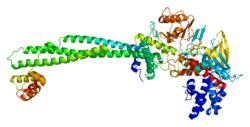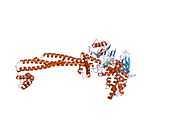RCOR1
REST corepressor 1 also known as CoREST is a protein that in humans is encoded by the RCOR1 gene.[1][2]
Function
This gene encodes a protein that is well-conserved, downregulated at birth, and with a specific role in determining neural cell differentiation. The encoded protein binds to the C-terminal domain of REST (repressor element-1 silencing transcription factor).[2]
Interactions
RCOR1 has been shown to interact with
References
- ↑ 1.0 1.1 Andrés ME, Burger C, Peral-Rubio MJ, Battaglioli E, Anderson ME, Grimes J et al. (September 1999). "CoREST: a functional corepressor required for regulation of neural-specific gene expression". Proc. Natl. Acad. Sci. U.S.A. 96 (17): 9873–8. doi:10.1073/pnas.96.17.9873. PMC 22303. PMID 10449787. Vancouver style error (help)
- ↑ 2.0 2.1 "Entrez Gene: RCOR1 REST corepressor 1".
- ↑ 3.0 3.1 3.2 3.3 Hakimi MA, Bochar DA, Chenoweth J, Lane WS, Mandel G, Shiekhattar R (May 2002). "A core-BRAF35 complex containing histone deacetylase mediates repression of neuronal-specific genes". Proc. Natl. Acad. Sci. U.S.A. 99 (11): 7420–5. doi:10.1073/pnas.112008599. PMC 124246. PMID 12032298.
- ↑ 4.0 4.1 You A, Tong JK, Grozinger CM, Schreiber SL (February 2001). "CoREST is an integral component of the CoREST- human histone deacetylase complex". Proc. Natl. Acad. Sci. U.S.A. 98 (4): 1454–8. doi:10.1073/pnas.98.4.1454. PMC 29278. PMID 11171972.
- ↑ Iwase S, Januma A, Miyamoto K, Shono N, Honda A, Yanagisawa J et al. (September 2004). "Characterization of BHC80 in BRAF-HDAC complex, involved in neuron-specific gene repression". Biochem. Biophys. Res. Commun. 322 (2): 601–8. doi:10.1016/j.bbrc.2004.07.163. PMID 15325272.
Further reading
- Nomura N, Nagase T, Miyajima N, Sazuka T, Tanaka A, Sato S et al. (1994). "Prediction of the coding sequences of unidentified human genes. II. The coding sequences of 40 new genes (KIAA0041-KIAA0080) deduced by analysis of cDNA clones from human cell line KG-1". DNA Res. 1 (5): 223–9. doi:10.1093/dnares/1.5.223. PMID 7584044.
- Andersson B, Wentland MA, Ricafrente JY, Liu W, Gibbs RA (1996). "A "double adaptor" method for improved shotgun library construction". Anal. Biochem. 236 (1): 107–13. doi:10.1006/abio.1996.0138. PMID 8619474.
- Yu W, Andersson B, Worley KC, Muzny DM, Ding Y, Liu W et al. (1997). "Large-scale concatenation cDNA sequencing". Genome Res. 7 (4): 353–8. doi:10.1101/gr.7.4.353. PMC 139146. PMID 9110174.
- Grimes JA, Nielsen SJ, Battaglioli E, Miska EA, Speh JC, Berry DL et al. (2000). "The co-repressor mSin3A is a functional component of the REST-CoREST repressor complex". J. Biol. Chem. 275 (13): 9461–7. doi:10.1074/jbc.275.13.9461. PMID 10734093.
- Hartley JL, Temple GF, Brasch MA (2000). "DNA cloning using in vitro site-specific recombination". Genome Res. 10 (11): 1788–95. doi:10.1101/gr.143000. PMC 310948. PMID 11076863.
- Humphrey GW, Wang Y, Russanova VR, Hirai T, Qin J, Nakatani Y et al. (2001). "Stable histone deacetylase complexes distinguished by the presence of SANT domain proteins CoREST/kiaa0071 and Mta-L1". J. Biol. Chem. 276 (9): 6817–24. doi:10.1074/jbc.M007372200. PMID 11102443.
- You A, Tong JK, Grozinger CM, Schreiber SL (2001). "CoREST is an integral component of the CoREST- human histone deacetylase complex". Proc. Natl. Acad. Sci. U.S.A. 98 (4): 1454–8. doi:10.1073/pnas.98.4.1454. PMC 29278. PMID 11171972.
- Ballas N, Battaglioli E, Atouf F, Andres ME, Chenoweth J, Anderson ME et al. (2001). "Regulation of neuronal traits by a novel transcriptional complex". Neuron 31 (3): 353–65. doi:10.1016/S0896-6273(01)00371-3. PMID 11516394.
- Hakimi MA, Bochar DA, Chenoweth J, Lane WS, Mandel G, Shiekhattar R (2002). "A core-BRAF35 complex containing histone deacetylase mediates repression of neuronal-specific genes". Proc. Natl. Acad. Sci. U.S.A. 99 (11): 7420–5. doi:10.1073/pnas.112008599. PMC 124246. PMID 12032298.
- Battaglioli E, Andrés ME, Rose DW, Chenoweth JG, Rosenfeld MG, Anderson ME et al. (2002). "REST repression of neuronal genes requires components of the hSWI.SNF complex". J. Biol. Chem. 277 (43): 41038–45. doi:10.1074/jbc.M205691200. PMID 12192000. Vancouver style error (help)
- Lunyak VV, Burgess R, Prefontaine GG, Nelson C, Sze SH, Chenoweth J et al. (2002). "Corepressor-dependent silencing of chromosomal regions encoding neuronal genes". Science 298 (5599): 1747–52. doi:10.1126/science.1076469. PMID 12399542.
- Hakimi MA, Dong Y, Lane WS, Speicher DW, Shiekhattar R (2003). "A candidate X-linked mental retardation gene is a component of a new family of histone deacetylase-containing complexes". J. Biol. Chem. 278 (9): 7234–9. doi:10.1074/jbc.M208992200. PMID 12493763.
- Iwase S, Januma A, Miyamoto K, Shono N, Honda A, Yanagisawa J et al. (2004). "Characterization of BHC80 in BRAF-HDAC complex, involved in neuron-specific gene repression". Biochem. Biophys. Res. Commun. 322 (2): 601–8. doi:10.1016/j.bbrc.2004.07.163. PMID 15325272.
- Gu H, Liang Y, Mandel G, Roizman B (2005). "Components of the REST/CoREST/histone deacetylase repressor complex are disrupted, modified, and translocated in HSV-1-infected cells". Proc. Natl. Acad. Sci. U.S.A. 102 (21): 7571–6. doi:10.1073/pnas.0502658102. PMC 1140450. PMID 15897453.
- Lee MG, Wynder C, Cooch N, Shiekhattar R (2005). "An essential role for CoREST in nucleosomal histone 3 lysine 4 demethylation". Nature 437 (7057): 432–5. doi:10.1038/nature04021. PMID 16079794.
- Shi YJ, Matson C, Lan F, Iwase S, Baba T, Shi Y (2005). "Regulation of LSD1 histone demethylase activity by its associated factors". Mol. Cell 19 (6): 857–64. doi:10.1016/j.molcel.2005.08.027. PMID 16140033.
- Nousiainen M, Silljé HH, Sauer G, Nigg EA, Körner R (2006). "Phosphoproteome analysis of the human mitotic spindle". Proc. Natl. Acad. Sci. U.S.A. 103 (14): 5391–6. doi:10.1073/pnas.0507066103. PMC 1459365. PMID 16565220. Vancouver style error (help)
| |||||||||||||
| ||||||||||||||||||||||||||||
This article incorporates text from the United States National Library of Medicine, which is in the public domain.



